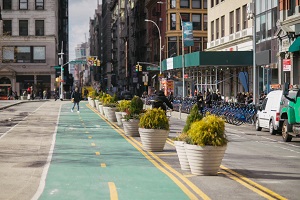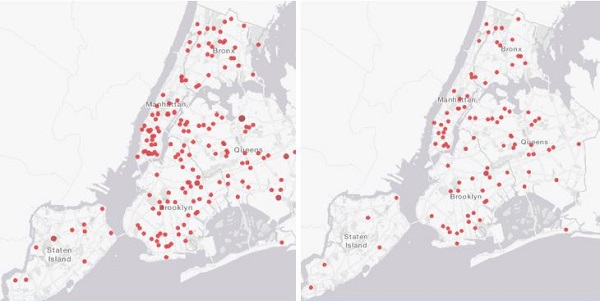Problem
Walking and biking are two modes of travel that have rapidly gained in popularity in New York City (NYC)–in fact, NYC has seen bicycling activity quadruple over the last decade.1 Contributing to this rise is the "Citi Bike" program, NYC's bikeshare system, which accounted for nearly 14 million bicycle trips in 2016. However, non-motorized transportation modes are not without risk. In 2013, the city experienced 178 pedestrian fatalities and 134 bicyclist fatalities.2 The following year, NYC adopted Vision Zero.

Solution
NYC has implemented a 5-year approach (2014-2019) to achieve Vision Zero that incorporates "Complete Streets" design, outreach, enforcement, legislation, and informational campaigns. Key to successful implementation has been the cooperation and integration of efforts between various city departments and State agencies. These include the New York City Department of Citywide Administrative Services (DCAS), the New York City Department of Transportation (NYCDOT), the New York City Taxi and Limousine Commission (TLC), the New York City Police Department (NYPD), the District Attorney's Offices for the five counties located in New York City, the New York City Law Department, the New York City Office of Management and Budget, and the State-run Metropolitan Transit Authority.
In 2016, the city spent $160 million to implement Vision Zero. Following are some of the key activities and achievements.
Street Design

- NYC developed a pedestrian safety plan for each borough. Strategies to improve pedestrian safety include clarifying different travel modes using pavement markings and road design features to separate drivers from pedestrians and cyclists.
- Since 2014, NYCDOT has completed 420 safety reengineering projects, reflecting a 138-percent increase in the rate of implementation for these projects compared to before Vision Zero. These projects include more than 65 miles of protected bike lanes.
- The city is focusing on implementing more speed bumps, traffic signals, and leading pedestrian intervals than prior to the adoption of Vision Zero.
Outreach
- NYCDOT's Safety Education team visits 600 schools each year through its safety education initiatives like Cross This Way, We're Walking Here, and helmet fittings and giveaways.
- Senior citizens make up 13 percent of the city's population yet account for approximately half of pedestrian fatalities. NYCDOT works with more than 100 senior-specific organizations to communicate safety information and obtain feedback on engineering changes. It also publishes a safety magazine geared toward seniors called StreetWise.
- The Vision Zero View map, which is available to the public, displays the locations of fatalities, injuries, and safety interventions in the city. In 2017, 58,697 injuries were recorded for all modes. (See map.)
- NYC solicited and analyzed public input on locations that should receive Vision Zero treatment, receiving more than 10,000 comments.
- Major street engineering projects are accompanied by public meetings to seek feedback and allow local residents to discuss any concerns.
- DCAS launched an annual forum with public and private fleet operators to coordinate safety strategies.

Source: http://www.nycvzv.info/.
Source: http://www.nycvzv.info/.
Enforcement
- The TLC adjusted its disciplinary system, imposing an additional license penalty when taxi drivers receive red light camera citations.
- The NYPD Chief of Transportation holds weekly TrafficStat meetings at NYPD headquarters to review crash data and determine enforcement priorities.
- NYPD ramped up its enforcement focus on speeding, failure to yield to pedestrians, signal violations, improper turns, disobeying signage, and distracted driving, which are the offenses most likely to injure or kill pedestrians. About two-thirds of all moving violations are now issued for these "Vision Zero violations."
- NYCDOT added automated speed enforcement in 140 school zones—and is planning to add more.
Legislation
- Recent city bills enhanced data collection and enforcement, codified safety engineering commitments, and updated the legal code to strengthen penalties for dangerous driving and failure to yield to pedestrians.
- The city enacted a State law which authorized it to lower the default speed limit from 30 mph to 25 mph and establish a traffic safety camera program.
- The city is strengthening several laws to protect bicyclists and pedestrians. One such program requires side guards (vehicle-based safety devices designed to keep pedestrians, bicyclists, and motorcyclists from being run over by large trucks' rear wheels in a side-impact collision) for all municipal and commercial waste trucks operating in the city by 2024,3 the largest such program in the country. To date, more than 2,000 trucks have side guards installed.
Campaigns
- NYC uses extensive advertising—social media, radio, video, print, special events—targeting drivers to reduce the dangers posed by speeding and aggressive turns. The first Vision Zero messaging campaign, Your Choices Matter, was followed in 2017 by Signs, which focuses on showing drivers that following the rules of the road is easy and saves lives.
- Dusk and Darkness is an annual partnership by NYCDOT, NYPD, and the TLC to enforce traffic laws and encourage safer driving during the weeks following the end of daylight saving time, when it becomes darker earlier in the evening and when pedestrian fatalities have typically risen.
Early Successes
Vision Zero is an ambitious goal. By adopting it, NYC committed to eliminating traffic fatalities and injuries. The city has seen very positive results in a number of areas where solutions were implemented, even though the program is in its early stages. A portion of funding for the Vision Zero program came from the Highway Safety Improvement Program (HSIP), which is an FHWA program that provides funding for safety projects. The HSIP in New York is administered by the New York State Department of Transportation.
Highlights include the following:
- The first 4 years after the adoption of Vision Zero was the safest 4-year period for traffic collisions in New York City's history. Fatalities in 2018 are at their lowest rate since 1910, when record-keeping began.
- Pedestrian deaths have fallen 42 percent, and overall traffic-related deaths fell 26 percent from the year before Vision Zero began.
- NYC has seen a 60-percent decrease in pedestrian and bicyclist deaths and serious injuries in locations where leading pedestrian intervals were added.
- NYC is more equitably disbursing traffic safety improvements by relying on data to identify locations in need of treatment rather than responding to public complaints, which often underrepresent social and environmental justice communities.
- NYC established coordinated reporting of collisions and aggressive driver behavior through in-vehicle technology across the fleet of city government vehicles–this has improved driver safety and contributed to a precipitous decline in serious crashes involving the city's fleet.
- In partnership with the U.S. DOT's Volpe Center, in May 2017 NYC launched a Safe Fleet Transition Plan that mandates installation of automatic braking and other technologies in city fleet vehicles to further reduce the number and severity of city-involved collisions. Based on available crash data, rear-end crashes are the largest single cause of preventable and injury-causing collisions for the city fleet. NYC has already implemented over 15,000 additional safety improvements on city fleet units through this initiative.
1 Mayor Bill de Blasio, Vision Zero Action Plan 2014, https://www.nyc.gov/html/visionzero/pdf/nyc-vision-zero-action-plan.pdf, pg. 24.
2 Mayor Bill de Blasio, Bicycle Crash Data Report 2013, https://www.nyc.gov/html/dot/downloads/pdf/2013-bicycle-crash-data-report.pdf pg. 2.
3 Mayor Bill de Blasio, Vision Zero Action Plan 2014, https://www.nyc.gov/html/visionzero/pdf/nyc-vision-zero-action-plan.pdf pg. 24, 25.
